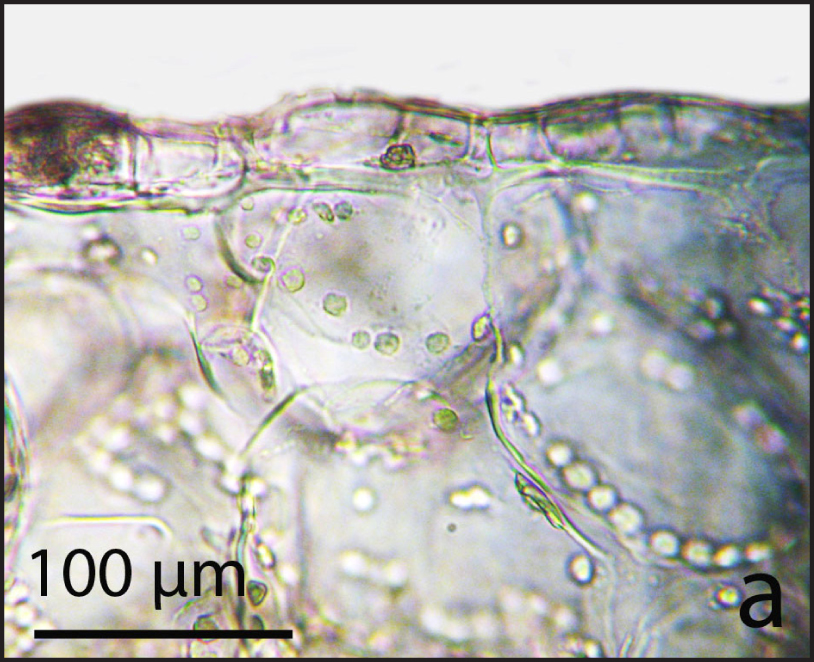Anatomical structure of the stem and drought resistance of Aylostera flavistyla, Mammillaria bocasana and Echinocactus grusonii
Abstract
The anatomy of Aylostera flavistyla, Mammillaria bocasana and Echinocactus grusonii stems was studied. Different trends of plants’ adaptation to condition of water deficit were identified. It was shown that the most drought-resistant plant is E. grusonii, and the less drought-tolerant is M. bocasana.
References
[Zhang D.H., Tohtar’ V.K. 2011. Research on drought tolerance of perspective species Momordica charantia L. and M. balsamina L. (Cucurbitaceae). Sci. News. Ser. Nat. Sci. 9 (15): 43–47. (In Russian)]
Захаревич С.Ф. 1954. К методике описания листа. Вестник Ленинград. Ун-та 4: 65–75.
[Zaharevich S.F. 1954. Toward the method of leaf description. Proc. Leningrad Univer. 4: 65–75. (In Russian)]
Паушева З.П. 1988. Практикум по цитологии растений. Агропромиздат, Москва.
[Pausheva Z.P. 1988. Practicum on plant cytology. Agropromizdat, Moscow. (In Russian)]
Ромейс Б. 1954. Микроскопическая техника. Изд-во иностранной литературы, Москва.
[Romeys B. 1954. Microscopic technics. Publ. of foreig. literature, Moscow. (In Russian)]
Anderson E.F. 2001. The cactus family. Timber Press, Portland, Oregon.
Ayala-Cordero G., Terrazas T., Lopez-Mata L., Trejo C. 2006. Morpho-anatomical changes and photosynthetic metabolism of Stenocereus beneckei seedlings under soil water deficit. J. Exp. Bot. 57: 3165–3174.
Monje P.V., Baran E.J. 2002. Characterization of calcium oxalates generated as biominerals in cacti. Plant Physiology 128: 707–713.
Nobel P.S. (ed.) 2002. Cacti: Biology and uses. University of California Press.
Rosas U., Zhou R.W., Castillo G., Collazo-Ortega M. 2012. Developmental reaction norms for water stressed seedlings of succulent cacti. PLoS ONE 7 (3): e33936. doi: 10.1371/journal.phone.0033936.
Ruiz L.P., Mansfield T.A. 1994. A postulated role for calcium oxalate in the regulation of calcium ions in the vicinity of stomatal guard cells. New Phytologist 127: 473–476.
Secorun A.C., de Souza L.A. 2011. Morphology and anatomy of Rhipsalis cereuscula, Rhipsalis floccose subsp. hohenauensis and Lepismium cruciforme (Cactaceae) seedlings. Rev. Mex. Biodivers. 82: 131–143.
Smith S.D., Didden-Zopfy B., Nobel P.S. 1984. High-temperature responses of North American cacti. Ecology 65: 643–651.
Zarinkamar F. 2007. Stomatal observations in Dicotyledons. Pak. J. Biol. Sci. 10 (2): 199–219.


This work is licensed under a Creative Commons Attribution-NonCommercial-NoDerivatives 4.0 International License.
The journal is licensed by Creative Commons under BY-NC-ND license. You are welcome and free to share (copy and redistribute the material in any medium or format) all the published materials. You may not use the material for commercial purposes. You must give appropriate credit to all published materials.
The journal allow the author(s) to hold the copyrights and to retain publishing rights without any restrictions. This is also indicated at the bottom of each article.





